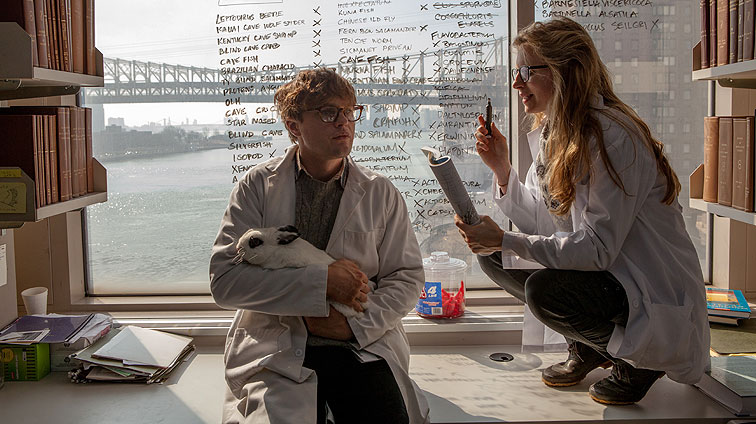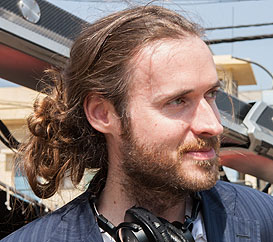
The Eyes Have It
Mike Cahill ponders the big questions about science, God, coincidence, and the nature of attraction all through the lens of the human eye in his ambitious indie drama I Origins.
 Mike Cahill
Mike Cahill
We have been charged with the task of giving our lives meaning through narrative. They don’t have to be true, but they just pour meaning into our lives. It's our responsibility to give our lives meaning.
With I Origins, writer-director Mike Cahill is now two for two telling human stories through science. His first feature, co-scripted with Georgetown classmate Brit Marling, Another Earth, presents parallel universes explained by theoretical physics’ string theory. I Origins, which premiered at Sundance 2014, posits a character-driven squaring of the circle between observable fact and faith, science and God, through the modern technology of iris-biometrics. No, really.
There are those who believe the eye is too complex and specific an organ to be explained by natural selection and evolution, so Cahill’s protagonists, Dr. Ian Gray (Boardwalk Empire alum Michael Pitt) and his lab partner Karen, played by Marling, set out to prove the naturally occurring origins of the eye. While there is plenty of science going on and exposition to transmit to the audience, though, Cahill roots himself firmly in two love stories with sharply defined characters, which invests his audience and carries him through.
It was an idea Cahill nursed and researched for years. After Another Earth, which he co-wrote, produced, directed, edited and directed photography (all of which he would do again for his sophomore effort), Cahill developed a treatment for I Origins and brought it to script stage after showing it to Pitt. With his longtime collaborator Marling already on board, the challenges of making a low-budget indie film really began.
This is your second film using metaphors of natural or scientific phenomenon to tell stories of human experience. Why is that a useful or exciting format for you?
I'm inspired by science. As an artist or writer you are trying to transmit an emotion to an audience. You want that to be rare, unique and powerful. For it to be rare and unique, you need new landscapes to tell stories. My last film had to do with parallel universes, this one has to do with my iris biometrics and the reoccurrence of precise iris patterns in infants. If you tell stories using cutting-edge science—string theory, biometrics—you have all of a sudden a new landscape to try and get to some fundamental, existential questions we have—questions of loneliness or death and what happens after we die, fear of death—trying to form a narrative that can explain that feeling that you have when you look in someone's eyes for the first time and recognize them, feel connected immediately. In a way, ever since those Existentialist writers of times past, we have been charged with the task of giving our lives meaning through narrative. They don’t have to be true, but they just pour meaning into our lives. It's our responsibility to give our lives meaning. I take that very seriously and want to tell stories that could feel real.
Giving our lives meaning, discovering what makes us happy or content, is the work of philosophy. I've had this thought that truly relevant philosophy might then have to be found through biology as the core of who we are, and therefore potentially revelatory of what we’re meant to be doing. Maybe that's where it is?
Right, maybe that's where it is! Exactly. That's definitely where I would sniff around and look for it, for sure. We're learning more every day. If you think about the sum total of human knowledge as a circle, that circle is expanding just like the universe is expanding. Hopefully it will expand infinitely just like the universe is expanding infinitely, but the force that propels expansion is the work of scientists. We know more Tuesday then we did on Monday because on Monday night some scientist discovered something. And that might be a biologist, an astronomer, a chemical engineer. There is something to it. The more and more we learn, the closer we get to understanding what this is all about. I don't think we'll get farther away.
Tell me about the use of coincidence and even outrageous coincidence as a screenwriter. At one point in the story, Ian experiences recurring number elevens, and follows them to his destiny. But how do you use it and keep it believable?
Think of the master writer, Paul Thomas Anderson. He spent so much time at the front of Magnolia preparing the audience to accept a coincidence late in the film. To sophisticated viewers, third act coincidence, the hand of God, deus ex machina, is a no-no. You can't do that. In a fictional story it doesn't feel fair, even if it's realistic, and he managed to set it up in such a way to say, “Hey, look, coincidences do happen. Believe this one, it's a whopper.” I'm conscious of that notion that you can get away with a coincidence early on, sometimes, if it's the tear, the thing that sets us off from the status quo. The protagonist’s break from status quo can be a coincidence. But later on it's not really helpful. Here I used coincidence in one very specific way, which was those elevens early on in the film. We have a protagonist who is a scientist, a rational guy. The last thing in the world he would ever give credence to is numerology or the sudden appearance of coincidental numbers. It is sort of a testament to Michael Pitt’s acting to be able to pull this off. 95 percent of his being is opposed to this. A scientist wouldn't follow this sort of hocus-pocus, but five percent of him, almost as if it were a string jutting from his tooth, drew him towards that.
In a way I was using it to create a three-dimensional character who is human. You might believe something so intensely, but you also have a little touch of doubt. If that doubt can be pulled on, it can be unraveled. After following the elevens and finding this woman, he tries to explain it as a scientist might by saying, “Four and a half billion years ago life was founded on the greatest coincidence of all time, DNA and RNA. Life was forced out of the primordial soup so life is the greatest coincidence.” The anthropomorphic principle, the coincidence of life is designed for us to be the viewer of it. It's funny how logicians will try to wrestle with such a thing. It was a way to really inform his character by doing the opposite.
I try and do that a lot in writing. For example, when Karen catches Ian masturbating, I thought, I have a goal as a writer here: to show that they love each other deeply. So what am I going to do? Have them walk on the beach holding hands in the sunset? Or, put them in the worst situation possible and have him do the worst thing he could do, which is to masturbate to video of his dead ex-wife while his pregnant wife catches him. If these two characters can get to the end of that scene without killing each other, I'm going to be convinced that they fucking love each other more than anybody. I like to throw the thing that is the opposite of what I'm trying to get at the characters, and see if they can swim through it.
You have a good deal of highly technical exposition to get through. How do you balance it so that you don't kill your audience?
I hope I pull it off though I'm not entirely convinced I do. I try and layer the technical exposition with romantic subtext, or least subtext of a relationship starting to bud. Karen and Ian might be saying, “Blah, blah, blah, paxis, evolution of the eye, blah blah blah, let's genetically modify these things.” But we know that what's really going on is Ian is totally underestimating her, and she is proving to be much more on his wavelength, and more admirable than any scientist he has probably met; that's what's unfolding in the subtext. We, as an audience, have to understand the technical jargon, but we’re feeling the subtext. But they could be speaking Greek, really.
Tell me how you found this metaphor of the eyes. Were you looking for the metaphor to fit what you wanted to talk about or the reverse?
The concept came maybe 12 years ago. I approach stories where concept comes first, then the characters that populate that world come second. I had a concept then thought about what kind of story I wanted to tell with it, and who would be the character. You look for what would be the strongest reversal, which is atheist maybe believing. How do you get Richard Dawkins to pray? Good luck. But if you can do it, what a feat!
Is a story like this the wish fulfillment of a logical person, coming to terms with science and spirituality for yourself?
I never thought of it that way but maybe. Take any great narrative that has survived throughout history. It's serving some sort of evolutionary purpose: it makes us feel at ease. Otherwise we’re dealing with chaos and insanity. Part of the storyteller's job is to create narratives that make us feel peaceful.
© 2014 Writers Guild of America West
